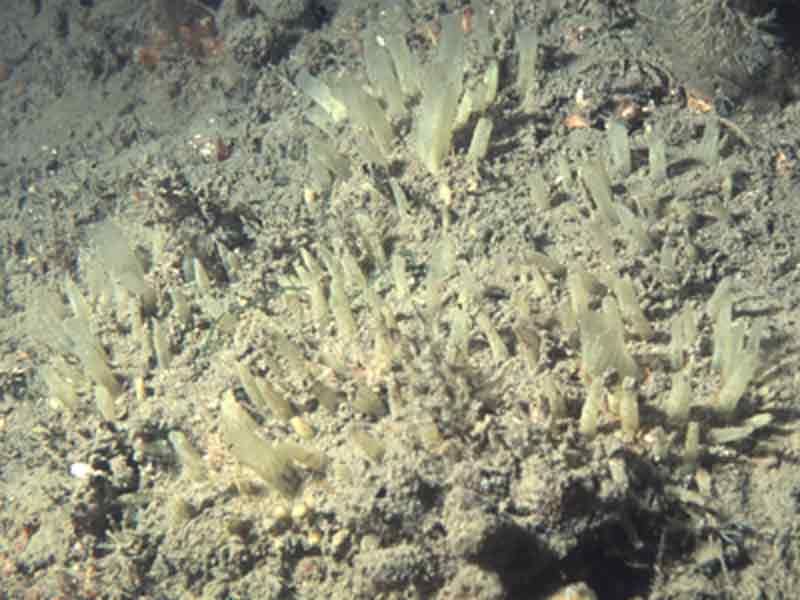Papillate sponge (Polymastia mamillaris)
Distribution data supplied by the Ocean Biodiversity Information System (OBIS). To interrogate UK data visit the NBN Atlas.Map Help
| Researched by | Susie Ballerstedt | Refereed by | Admin |
| Authority | (Müller, 1806) | ||
| Other common names | - | Synonyms | - |
Summary
Description
A low, spreading cushion of up to 2 cm thickness with a base diameter of up to 12 cm. The sponge surface is hard and rough with a variable number of erect projections bearing a terminal opening (papillae) that may be as tall as 12 cm. The main body mass is pale, usually greyish yellow or more rarely, orangey yellow, and is often buried in sediment with only the papillae visible. The papillae are smooth and clean, creamy white or pale yellow, sometimes translucent, and often a fine network of spicules can be seen on their surface. The exhalant papillae are large and few in number, the inhalant papillae are smaller.
Recorded distribution in Britain and Ireland
Common around the British Isles.Global distribution
Arctic-Atlantic coasts of Europe and North America, and the Mediterranean.Habitat
Often found at the sediment-bedrock interface on upward facing rock, or growing out of crevices. Prefers silty conditions and is recorded from the littoral to a depth of 2300 m, but usually occurs between 5-15 m.Depth range
-Identifying features
- Low, spreading cushion up to 2 cm thick and 12 cm in diameter.
- Main body mass pale greyish yellow, or more rarely, orange-yellow.
- Body surface rough with a number of erect, smooth projections (papillae).
- Papillae creamy white or pale yellow in colour and up to 12 cm in height.
- Exhalant papillae large and few in number, inhalant papillae smaller.
Additional information
May be confused with Polymastia robusta, however the papillae of this closely related species tend to fuse together, which does not occur in Polymastia mamillaris.
Listed by
- none -
Bibliography
Bruce, J.R., Colman, J.S. & Jones, N.S., 1963. Marine fauna of the Isle of Man. Liverpool: Liverpool University Press.
Hayward, P.J. & Ryland, J.S. (ed.) 1995b. Handbook of the marine fauna of North-West Europe. Oxford: Oxford University Press.
JNCC (Joint Nature Conservation Committee), 1999. Marine Environment Resource Mapping And Information Database (MERMAID): Marine Nature Conservation Review Survey Database. [on-line] http://www.jncc.gov.uk/mermaid
Picton, B.E. & Costello, M.J., 1998. BioMar biotope viewer: a guide to marine habitats, fauna and flora of Britain and Ireland. [CD-ROM] Environmental Sciences Unit, Trinity College, Dublin.
Van Soest, R.W.M., Picton, B. & Morrow, C., 2000. Sponges of the North East Atlantic. [CD-ROM] Windows version 1.0. Amsterdam: Biodiversity Center of ETI, Multimedia Interactive Software. [World Biodiversity Database CD-ROM Series.]
Datasets
Centre for Environmental Data and Recording, 2018. Ulster Museum Marine Surveys of Northern Ireland Coastal Waters. Occurrence dataset https://www.nmni.com/CEDaR/CEDaR-Centre-for-Environmental-Data-and-Recording.aspx accessed via NBNAtlas.org on 2018-09-25.
Manx Biological Recording Partnership, 2022. Isle of Man historical wildlife records 1990 to 1994. Occurrence dataset:https://doi.org/10.15468/aru16v accessed via GBIF.org on 2024-09-27.
NBN (National Biodiversity Network) Atlas. Available from: https://www.nbnatlas.org.
OBIS (Ocean Biodiversity Information System), 2025. Global map of species distribution using gridded data. Available from: Ocean Biogeographic Information System. www.iobis.org. Accessed: 2025-08-08
South East Wales Biodiversity Records Centre, 2023. SEWBReC Marine and other Aquatic Invertebrates (South East Wales). Occurrence dataset:https://doi.org/10.15468/zxy1n6 accessed via GBIF.org on 2024-09-27.
Citation
This review can be cited as:
Last Updated: 10/11/2006



